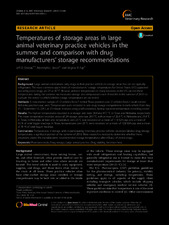| dc.creator | Ondrak, Jeff D. | |
| dc.creator | Jones, Meredyth L | |
| dc.creator | Fajt, Virginia R. | |
| dc.date.accessioned | 2018-05-18T21:42:10Z | |
| dc.date.available | 2018-05-18T21:42:10Z | |
| dc.date.issued | 2015 | |
| dc.identifier.citation | Ondrak JD, Jones ML, Fajt VR. Temperatures of storage areas in large animal veterinary practice vehicles in the summer and comparison with drug manufacturers’ storage recommendations. BMC Veterinary Research. 2015;11:248. doi:10.1186/s12917-015-0561-z. | en |
| dc.identifier.uri | https://hdl.handle.net/1969.1/166424 | |
| dc.description.abstract | Abstract
Background: Large animal veterinarians carry drugs in their practice vehicles in storage areas that are not typically refrigerated. The most common upper limits of manufacturers’ storage temperatures for United States (U.S.)-approved non-refrigerated drugs are 25 or 30 °C. Because ambient temperatures in many locations in the U.S. exceed these temperatures during the summer, we measured storage area temperatures over 4 months in the summer of 2013 to evaluate the extent to which labeled storage temperatures are exceeded. Methods: A convenience sample of 12 vehicles from 5 central Texas practices and 12 vehicles from 4 south central Nebraska practices was used. Temperatures were recorded in one drug storage compartment in each vehicle from May 15 – September 16, 2013, at 15-minute intervals using a self-contained, battery operated temperature recording device. Results: The highest temperatures recorded in a storage unit were 54.4 and 47.7 °C in Texas and Nebraska, respectively. The mean temperature recorded across all 24 storage units was 29.1 °C, with a mean of 26.9 °C in Nebraska and 31.4 °C in Texas. In Nebraska, at least one temperature over 25 °C was recorded on a mean of 111/124 days and a mean of
63 % of total logger readings. In Texas, temperatures over 25 °C were recorded on a mean of 123/124 days and a mean of 95 % of total logger readings. Conclusions: Temperatures in storage units in participating veterinary practice vehicles exceeded labeled drug storage temperatures a significant portion of the summer of 2013. More research is needed to determine whether these excursions above the manufacturers’ recommended storage temperatures alter efficacy of stored drugs. Keywords: Pharmaceuticals, Drug storage, Large animal practice, Drug stability, Excessive heat | en |
| dc.description.sponsorship | This study was supported by internal funds from the University of Nebraska-Lincoln and Texas A&M University. | en |
| dc.language.iso | en_US | |
| dc.publisher | BioMed Central | |
| dc.rights | Attribution-NonCommercial-ShareAlike 3.0 United States | en |
| dc.rights.uri | http://creativecommons.org/licenses/by-nc-sa/3.0/us/ | |
| dc.subject | Veterinary Medicine | en |
| dc.subject | Pharmaceuticals | en |
| dc.subject | Drug storage | en |
| dc.subject | Large animal practice | en |
| dc.subject | Drug stability | en |
| dc.subject | Excessive heat | en |
| dc.title | Temperatures of storage areas in large animal veterinary practice vehicles in the summer and comparison with drug manufacturers’ storage recommendations | en |
| dc.type | Article | en |
| local.department | Large Animal Clinical Sciences | en |
| local.department | Veterinary Physiology and Pharmacology | en |
| dc.identifier.doi | 10.1186/s12917-015-0561-z | |



